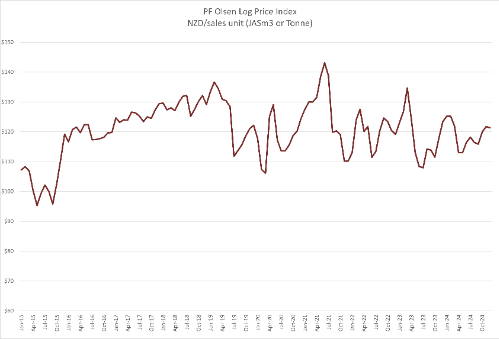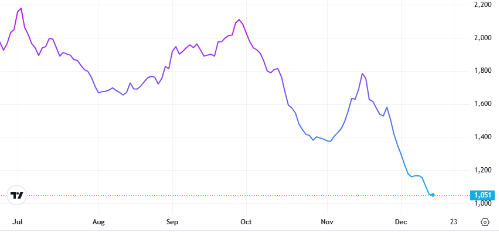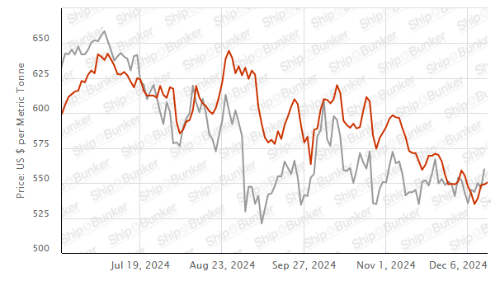
Everybody involved in log markets around the world will be waiting to see what happens to the balance between supply and demand early next year. The local market is eager to see what demand is like after the Christmas and New Years holiday period. Both local and China market participants will wait to see if log supply from New Zealand is reduced to match reduced demand in China during the Chinese New Year holiday period in late January. While India is waiting to see if log demand increases after the monsoon weather.
The CFR price range for A grade logs in China has dropped from US$125 per JASm3 last month to a range of US$118-124. A weaker NZD against the USD and slightly reduced shipping costs has reduced the negative impact of this price drop on At Wharf Gate (AWG) prices in New Zealand. December AWG prices for export sawlogs dropped $2 per JASm3 from November pricing.
The PF Olsen Log Price Index decreased $1 in December to NZ$121. The Index is now $3 above the two-year average, and $1 above the five-year average.
Domestic Log Market
Negotiations are ongoing between sawmill operators and forest owners for log pricing in Quarter 1, 2025. This is a difficult situation as mills seek price relief, but forest owners are in a position where their financial returns barely justify harvesting.
The construction industry is expected to remain weak in New Zealand. Advanced indicators of activity such as consent insurance remain low. The New Zealand economy continues to perform around the recessionary level. Many people are less secure about employment or business since, so are unlikely to spend on housing. Government spending is also down, and many projects involving building are likely to be delayed or reduced.
Export Log Markets
China
China softwood log inventory remains at 2.4m m3 with log demand also steady around 55k m3 per day. The CFR price range for A grade is currently in the range 118-124 per JASm3 for A grade.
The China Caixin Manufacturing PMI increased in November to 51.5 from 50.3 in October. (Any number above 50 signals manufacturing growth). It had the fastest manufacturing expansion since June, driven by strong growth in foreign orders. Employment levels fell again for the third time in a row. Confidence levels were at an eight-month high. Despite all this, log demand remains subdued in China. Mills will start to reduce inventory levels as they prepare for Chinese New Year. Many people in China are waiting to see what will happen with the relationship between China and the incoming USA government.
There has been a lot of comments about tariffs announced by the incoming USA government. What has been relatively unnoticed is the introduction or change in Russian tariffs on furniture parts manufactured in China. As an example, the tariff on sliding rail components in furniture has increased from 0 to 55.65% over the past few weeks. Interestingly, it is now more cost effective for Russians to import fully finished furniture from China (which incurs a 9-12% tariff) rather than manufacture the furniture in Russia, using parts from China. This tariff seems to be imposed by tariff hungry city officials, who are prioritising short-term tariff revenue over long term relationships and economics.
New Zealand pine logs are widely used in China for plywood manufacturing and China produces more than 70% of the world’s plywood. Nearly half of the USA’s total plywood imports last year came from China. Any tariffs imposed could have a significant effect on this supply chain. In recent months, FSC certified bamboo used in China, has come under increased scrutiny with some brands making false and misleading statements about sustainability.
India
Vessels have a waiting time of three to four weeks at Kandla port due to congestion. There are approximately nine log vessels arriving in January. The sale price of green-sawn timber in nearby Gandhidham is around 481 INR per CFT, with poor demand. The market expects demand to increase in January.
Log demand in Tuticorin remains weak as the Northeast monsoon rains continue until mid-January. The market expects demand to increase after the harvest festival in mid-January. The price for sawn timber in Tuticorin is around 621 INR per CFT. Green sawn timber is arriving from Gandhidham via coastal container shipping, due to the price differential with the Gandhidham market.
Exchange rates
The NZD weakened against the USD through December. If this trend continues it will offset some of the log price drops in China when calculating AWG pricing for January. The CNY also continues to weaken against the USD reducing the buying power of Chinese log buyers. This will put more downward pressure on log sale prices in China.
NZD:USD
CNY:USD
Shipping costs
Shipping costs have reduced and the price to ship logs from New Zealand to China is now in the low to mid 30’s USD range per JASm3.
The Bulk Dry Index (BDI) shown below is a composite of three sub-indices, each covering a different carrier size; Capesize (40%), Panamax (30%), and Supramax (30%). It displays an index of the daily USD hire rates across 20 ocean shipping routes. Whilst most of the NZ log trade is shipped in Handysize vessels, this segment is strongly influenced by the BDI. The BDI index is now at its lowest point since February this year. This decline is shown across all vessel segments.
Baltic Dry Index (BDI)
Source: TradingEconomics.com
Singapore Bunker Price (VLSO) (red line) versus Brent Oil Price (grey line)
Source: Ship & Bunker
PF Olsen Log Price Index - December 2024
The PF Olsen Log Price Index decreased $1 in December to $121. The Index is now $3 above the two-year average, and $1 above the five-year average.

Basis of Index: This Index is based on prices in the table below weighted in proportions that represent
a broad average of log grades produced from a typical pruned forest with an
approximate mix of 40% domestic and 60% export supply.
Indicative Average Current Log Prices – December 2024
| Log Grade | $/tonne at mill | $/JAS m3 at wharf | ||||||||||
| Dec-24 | Nov-24 | Oct-24 | Aug-24 | Jul-24 | Jun-24 | Dec-24 | Nov-24 | Oct-24 | Aug-24 | Jul-24 | Jun-24 | |
| Pruned (P40) | 175-200 | 175-200 | 175-200 | 175-200 | 175-200 | 175-200 | 190 | 190 | 180 | 175 | 175 | 180 |
| Structural (S30) | 120-145 | 120-145 | 120-145 | 120-145 | 120-145 | 120-145 | ||||||
| Structural (S20) | 93-100 | 93-100 | 93-100 | 93-100 | 93-100 | 93-100 | ||||||
| Export A | 126 | 128 | 125 | 118 | 118 | 114 | ||||||
| Export K | 117 | 119 | 116 | 107 | 109 | 105 | ||||||
| Export KI | 107 | 109 | 106 | 98 | 100 | 96 | ||||||
| Export KIS | 98 | 100 | 97 | 89 | 91 | 87 | ||||||
| Pulp | 46 | 46 | 46 | 46 | 46 | 46 | ||||||
Note: Actual prices will vary according to regional supply/demand balances, varying cost structures and grade variation. These prices should be used as a guide only.
A longer series of these prices is available here.
Log Prices
Select chart tabs
This article is reproduced from PF Olsen's Wood Matters, with permission.
3 Comments
I've often wondered why we don't have plants that manufacture to the flat-pack level for export. (e.g. furniture, MDF, ply, etc.)
Exporting flatpacks - rather than logs - must be far more space efficient on ships / train / trucks etc. The waste from raw logs stays here and be used for bio-fuels. Much of the energy required will be electricity and we can make much more of that renewably if we had better government.
Has anyone got access to a detailed cost/benefit paper on this? Doesn't matter how old. Thanks.
There is a term called "comparative competitiveness. " Cost of manufactory added, and NZ loses its competitiveness.
Logs are a very efficient way of transporting multiple products. When a log is processed to say sawn timber it also produces timber offcuts, sawdust and bark. To many this may seem to be waste but in fact these products are actually the profit portion of processsing. Offcuts are turned into chips for other products, sawdust and bark for fuel or again other wood products.
Transporting logs across the ocean is very cheap. For example the cost of freighting a log to China is well below the cost of harvesting and transporting the log to a wharf or mill in most situations, especially on steep and remoter sites. The mill offshore gets the timber from the log plus all the bits above to sell. In many of these markets the offcuts, sawdust and bark etc are very valuable products. If we tried to process the log here and then send all bits the freight is astronomical - it dosnt work. Alongside that processors have to deal with a very volatile exchange rate which can kill you.
It can work here but you need to be very smart and efficient. The most successful log grade we produce for domestic processors is pruned logs. These produce knot free timber from the outer wood. The reason this is successful is that the long clear boards are, virtually, not able to be produced anywhere else and go to the US and Europe. As a result the value of this product is vey high - 3 to 4x higher in value than lower grades of sawn timber exported to Asia.
Pruned logs will only make up 20 to 30% of the total log volume harvested in a pruned stand (but can make up over 60% of the net return) and it is not cheap to prune these days (labour intensive) and many don’t prune because of cost and the perceived lower return due to higher up front costs. Most of these logs are processed in NZ.
The challenge, as in meat etc, is to find profitable uses for the unpruned logs. Some regions do have a well balanced industry and do this. This requires capital, very good management skills and reliable material supply (what’s new!!!)
For the forest grower costs of production are key. Ground based harvest, easy engineering and low cart distances are the key to profit. Many forests on hard hill country are increasingly unprofitable, just like livestock farming.





We welcome your comments below. If you are not already registered, please register to comment.
Remember we welcome robust, respectful and insightful debate. We don't welcome abusive or defamatory comments and will de-register those repeatedly making such comments. Our current comment policy is here.